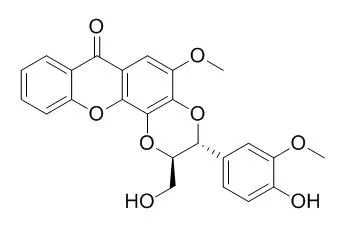| In vitro: |
| J Nat Prod. 2016 Mar 25;79(3):470-6. | | Antistaphylococcal Prenylated Acylphoroglucinol and Xanthones from Kielmeyera variabilis.[Pubmed: 26900954 ] |
METHODS AND RESULTS:
Bioactivity-guided fractionation of the EtOH extract of the branches of Kielmeyera variabilis led to the isolation of a new acylphoroglucinol (1), which was active against all the MRSA strains tested herein, with pronounced activity against strain EMRSA-16. Compound 1 displayed an MIC of 0.5 mg/L as compared with an MIC of 128 mg/L for the control antibiotic norfloxacin. The structure of the new compound was elucidated by 1D and 2D NMR spectroscopic analysis and mass spectrometry, and experimental and calculated ECD were used to determine the absolute configurations. The compounds β-sitosterol (2), stigmasterol (3), ergost-5-en-3-ol (4), and osajaxanthone (5) also occurred in the n-hexane fraction.
CONCLUSIONS:
The EtOAc fraction contained nine known xanthones: 3,6-dihydroxy-1,4,8-trimethoxyxanthone (6), 3,5-dihydroxy-4-methoxyxanthone (7), 3,4-dihydroxy-6,8-dimethoxyxanthone (8), 3,4-dihydroxy-2-methoxyxanthone (9), 5-hydroxy-1,3-dimethoxyxanthone (10), 4-hydroxy-2,3-dimethoxyxanthone (11), Kielcorin (12), 3-hydroxy-2-methoxyxanthone (13), and 2-hydroxy-1-methoxyxanthone (14), which showed moderate to low activity against the tested MRSA strains. | | Planta Med. 2011 Dec;77(18):2013-8. | | Anti-inflammatory xanthones from the twigs of Hypericum oblongifolium wall.[Pubmed: 21870324 ] |
METHODS AND RESULTS:
Two new xanthonolignoids, hypericorin A (1) and hypericorin B (2), along with five known new source compounds, a xanthonolignoid, Kielcorin (3), 4-hydroxy-2,3-dimethoxyxanthone (4), 3,4,5-trihydroxyxanthone (5), 1,3-dihydroxy-5-methoxyxanthone ( 6) and 1,3,7-trihydroxyxanthone (7), were isolated from the stems (twigs) of Hypericum oblongifolium Wall. The structures of the new compounds were deduced on the basis of spectroscopic techniques (EI-MS, HREI-MS, (1)H NMR, (13)C NMR, HMQC, HMBC, and NOESY). We also report herein for the first time the single crystal X-ray structure of compound 6.
CONCLUSIONS:
Compounds 1- 7 were screened for their IN VITRO anti-inflammatory (respiratory burst) inhibiting activities using isolated human neutrophils; compounds 1, 2, 3, 5, and 7 showed significant activities (IC (50) = 816.23 ± 73.30, 985.20 ± 55.80, 965.21 ± 65.80, 907.20 ± 50.80, 975.20 ± 81.10 μM, respectively), compound 6 showed moderate activity (IC (50) = 2500.85 ± 50.50 μM), while compound 4 was totally inactive at 1000 μg/mL as compared to the positive control used, indomethacin (IC (50) = 757.99 ± 5.90 μM), and aspirin (IC (50) = 279.44 ± 4.40 μM). Compound 4 was also inactive in comparison with other tested Hypericum compounds. |
|






 Cell. 2018 Jan 11;172(1-2):249-261.e12. doi: 10.1016/j.cell.2017.12.019.IF=36.216(2019)
Cell. 2018 Jan 11;172(1-2):249-261.e12. doi: 10.1016/j.cell.2017.12.019.IF=36.216(2019) Cell Metab. 2020 Mar 3;31(3):534-548.e5. doi: 10.1016/j.cmet.2020.01.002.IF=22.415(2019)
Cell Metab. 2020 Mar 3;31(3):534-548.e5. doi: 10.1016/j.cmet.2020.01.002.IF=22.415(2019) Mol Cell. 2017 Nov 16;68(4):673-685.e6. doi: 10.1016/j.molcel.2017.10.022.IF=14.548(2019)
Mol Cell. 2017 Nov 16;68(4):673-685.e6. doi: 10.1016/j.molcel.2017.10.022.IF=14.548(2019)